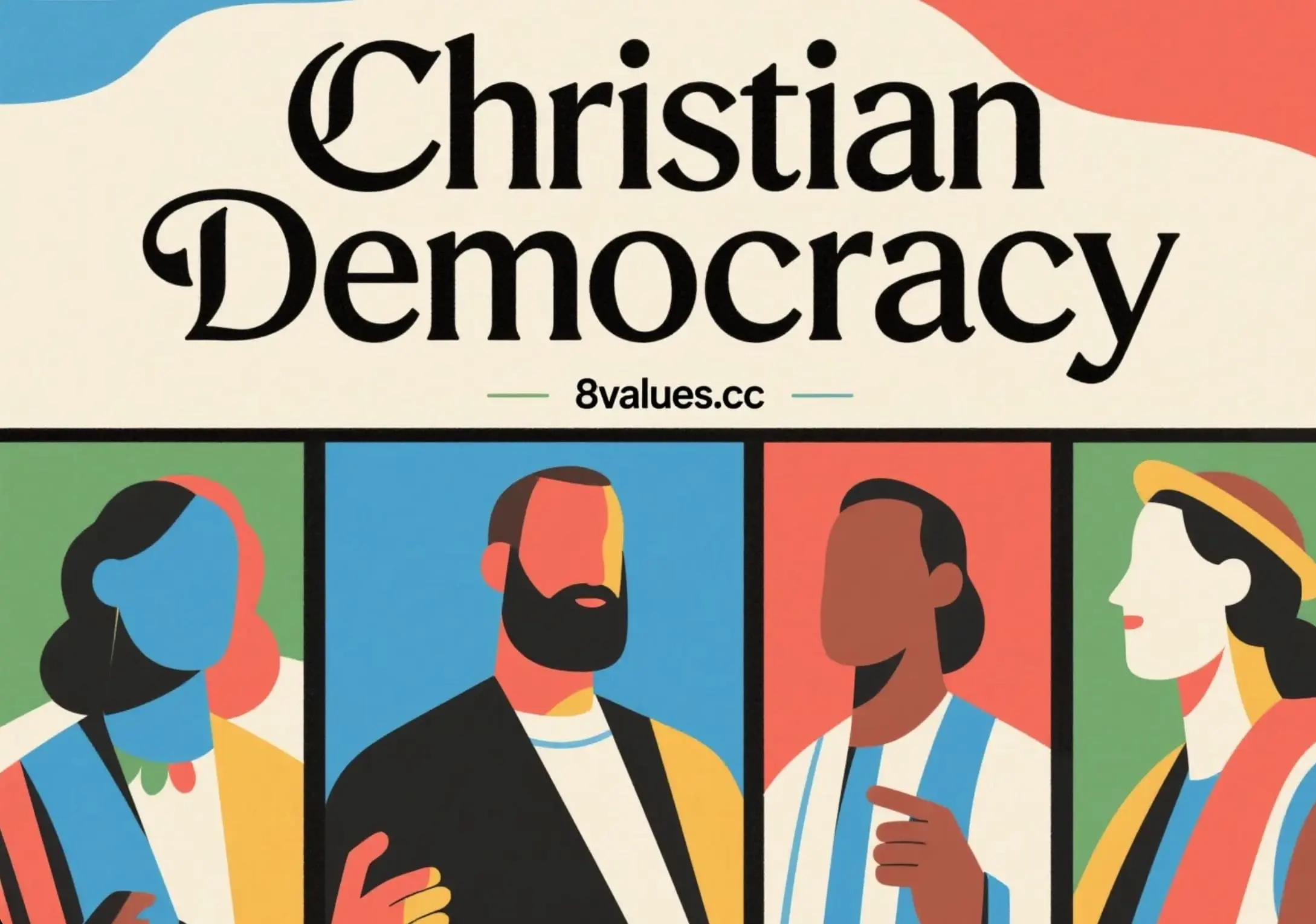In-depth interpretation of the political spectrum: the evolution from traditional left/right to multidimensional political coordinates
Political Spectrum, also known as political coordinates, is an analytical tool used to measure individuals' political stance tendencies (i.e., different ideologies). This article will provide a detailed introduction to the origin and evolution of the political spectrum, as well as the various uniaxial and multiaxial political tendency division models used in academic research and modern political tests such as the 8Values political test.
Political Spectrum is an analytical tool that compares or visualizes different political positions through one or more geometric axes. It is based on a core assumption that people's views on many important issues are strongly correlated, or that there is a fundamental issue that incorporates or controls all other issues, so that political positions can be classified and measured by their relevance.
The Origin of the Political Spectrum: Left and Right
The concept of political spectrum usually refers to the commonly used multidimensional political spectrum model, but its core divisions - the left and the right - originated in France in the late 18th century.
Seating division during the French Revolution: The political left and right originated from the early days of the French Revolution from 1789 to 1799. Among all the French legislatures at that time, the direction of the seat determined these two terms: the nobles sat on the right side of the speaker's seat, while the civilians sat on the left. Initially, the right supported the old system and supported the aristocracy, royal family and church; the left supported republicanism, secularism, and civil liberties.
Evolution and ambiguity of ideology:
- Early (early revolutionary period) : Due to the relatively narrow political suffrage at that time, the initial left mainly represented the interests of the bourgeoisie (emerging capitalist class). The left in parliament supported laissez-faire economy and free markets, which at the time represented policies favoring capitalists.
- Later evolution : As the scope of voting rights expanded, socialism and communism that advocated the interests of workers and poor peasants began to appear, changing the position of the left. Today, communism and socialism are often regarded internationally as leftists (usually emphasizing equality and social intervention). Conservatism and reactionaryism are often regarded as the right (usually focusing on freedom and economic laissez-faire).
Liberalism's position in the political spectrum is more complex, depending on the context. Sometimes it is seen as the left (such as social liberalism) and sometimes it is seen as the right (such as conservative liberalism and economic liberalism).
Limitations of uniaxial political coordinates and the rise of multi-axis models
Traditional political spectral models often use a single left and right axes to divide political tendencies, but political scientists have noticed that a single left and right axes are too simple to describe existing changes in political beliefs.
Various interpretation dimensions of left and right axes
Along the single left and right coordinate axes, various political views can be measured, which actually contain different substantive contents, resulting in the complexity of left and right division:
- Equality and freedom priority : Should the state give priority to equality (left) or should give priority to freedom (right).
- Level of economic intervention : Should the government interfere in economic affairs (left) or should keep economic affairs laissez-faire (right).
- Social Policy : Should the government take care of issues such as health care and retirement benefits (leftist) or do they think these issues should be left to individuals to deal with (rightist).
- Attitude to change : Should we accept change (leftist) or prefer to make rigorous proof of the legitimacy of change (rightist).
- Equality of results and processes : Is it important to emphasize the outcome of equality (left) or the process of equality (right).
The division of political tendencies
In the left and right division, people with medium views are sometimes classified as centrists , and centrists are also subdivided into center-left and center-right . The two factions that are too extreme are called extreme left and extreme right . Politics that do not use traditional left and right divisions at all are often called fusion politics .
Since the uniaxial model shows obvious inappropriateness in describing ideologies such as Anarchism and Laissez-faire libertarianism, the academic community has begun to turn to multi-coordinate systems.
Exploration of the Political Stance in Academic Research
For nearly a century, sociologists have been studying how to best describe political positions, proposing a variety of multidimensional political coordinate models.
Leonard Ferguson's research
In 1950, Leonard Ferguson analyzed people's attitudes toward ten aspects (including fertility control, death penalty, censorship, communism, etc.). He conducted a factor analysis of the results and identified three factors:
- Religionism : Related to belief in God and negative attitudes toward evolution and fertility control.
- Humanitarianism : Related to opposition to war, death penalty and severe treatment of criminals.
- Nationalism : reflects changes in opinions on censorship, law, patriotism and communism.
Ferguson's research was derived through exploratory empirical experiments, and its religious and humanitarian factors have been verified by repeated experiments.
Hans Eysenck's biaxial model
Following Ferguson's research, Hans Eisenk began to study British political attitudes. He believes that the National Socialists (Nazis) and Communists have opposite positions on the left and right axes, but have essentially similarities.
Eisenk used factor analysis method and concluded two factors:
- Radicalism (R-factor) : This is roughly the same as the traditional division of left and right positions. Radical tendencies (left) actively view evolutionary theory, strikes, welfare states, student protests, etc.; conservative tendencies (right) actively view white superiority, death penalty, anti-Semitism, etc.
- Gentle Mindset/Tough Mindset (T-factor) : There is no correlation between this factor and the R-factor. A tough mentality (those with high T-factor scores tend to be authoritarian) actively view compulsory sterilization, euthanasia, racism, death penalty and severe treatment of criminals; a moderate mentality (those with low T-factor scores tend to be democratic) positively view moral training, pacifism, opposition to discrimination and opposition to death penalty.
The core of Eisenk's argument is that moderate ideology is democratic and has a positive attitude towards human freedom; while tough ideology is aggressive and authoritative. Later, Eisenk improved methodology and added more economic problems, revealing that the left and right factions in social and economic policies describe different things, thus discovering a previously undiscovered socialist-capitalist (S-factor) axis .
Milton Rokeach's Freedom and Equality
Due to technical criticism of Eisenk's research, Milton Rokerchi proposed his own biaxial model of political coordinates in 1973, based on freedom and equality .
Roquech believes that the biggest difference between the left and the right is that the left emphasizes the importance of equality more than the right . He believes that although ideologies are different, ideologies like communism and Nazism pay less attention to freedom than more traditional social democrats or capitalists.
Through the analysis of the textual content of four ideologies (Socialism, Hitler, Gao Huade, and Lenin), Roquech obtained the following value ranking results:
- Socialists: Freedom ranks first, equality ranks second.
- Hitler (Nazism): Liberty ranked sixteenth and equality ranked seventeenth.
- Gao Huade (capitalism): Freedom ranks first, equality ranks sixteenth.
- Lenin (Communism): Ranked seventeenth in freedom and first in equality.
Analysis of modern multi-axis political test model
The uniaxial left-right division is difficult to accurately cover all political positions, prompting many to develop alternative multi-coordinate systems, especially those who believe that their views cannot be fully represented by traditional left-right spectrum.
Nolan Chart: Economic freedom and personal freedom
Libertarian David Nolan proposed the Nolan Curve , a biaxial model widely used in online political testing .
- Horizontal axis : Consider economic freedom factors (such as taxation, free trade and free enterprise issues).
- Vertical axis : Considering personal freedom factors (such as drug legalization, abortion and recruitment).
This coordinate chart places the left side on the left, the right side on the right, the Libertarians on the top, and the populists (or Authoritatives/Statists) originally named Nolan at the bottom.
Ingelhart-Wertzel: Cultural Ideological Map
Ronald Inglehart proposed a two-dimensional cultural ideological model based on the World Values Survey:
- Y-axis: Secularism – Traditionalism : covers traditional and religious issues such as patriotism, abortion, euthanasia, and the importance of obedience to authoritatives. The lower part represents the traditionalist position, and the top part represents the secular position.
- X-axis: Survivalism – Self-expression : A measure of daily behavior and clothing, acceptance of political diversity and innovation, and attitudes toward people with controversial lifestyles (e.g., gay, vegetarian). The right side represents an open self-expressionist position, and the left side is survivalism.
Other alternative political coordinate models
In addition to the above models, there are other biaxial and multiaxial models used to depict different political tendencies :
- Greenberg and Hornas model : Contains standard left and right axes and axes representing ideological rigidity . They believe that the rigidity of ideology allows "the concepts of dogmatism and authoritarianism to have much in common", which is characterized by "trust strong leaders and obedience, preference for their own inner groups, and aggression against dissidents."
- Pournelle Chart : One axis is freedom (pursuing uncontrolled freedom vs. emphasizing authority and protection of social norms), the other axis is rationalism (belief of planning social progress vs. doubts about this rational approach).
Understand personal political stance
Today, many popular online political tendency tests, such as 8values.cc official website, provide a variety of political tests , most of which use a biaxial model to classify individual political stances . These tests can help users better understand the specific position of their political tendencies in the socio-economic and socio-cultural dimensions.
If you want to explore your political values composition through scientific methods, you can try online political spectrum testing tools such as 8values Political Values Prone Test / 9Axes Political Test . It helps you determine your political coordinates and tendencies more carefully through multi-dimensional problem design. Understanding these different political coordinate models will not only help to understand the complex ideological world, but also help to recognize the limitations of a single left-right division in modern political analysis.






